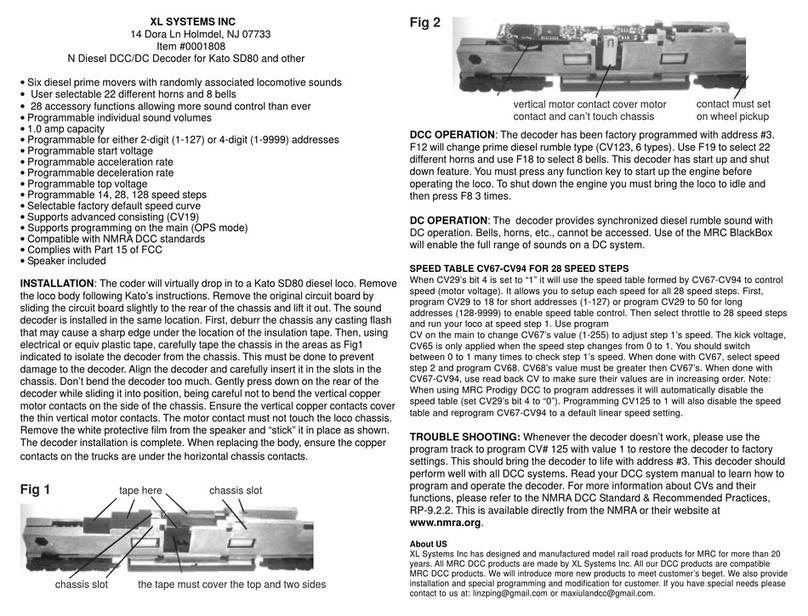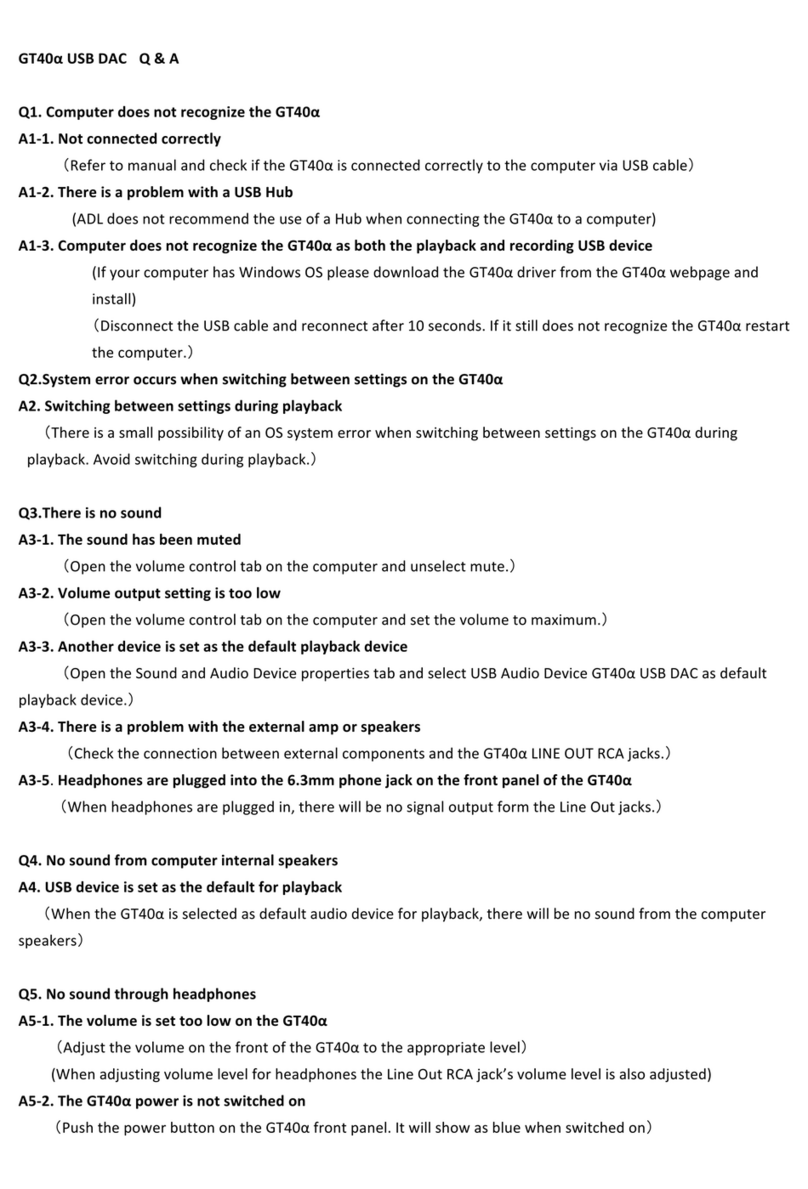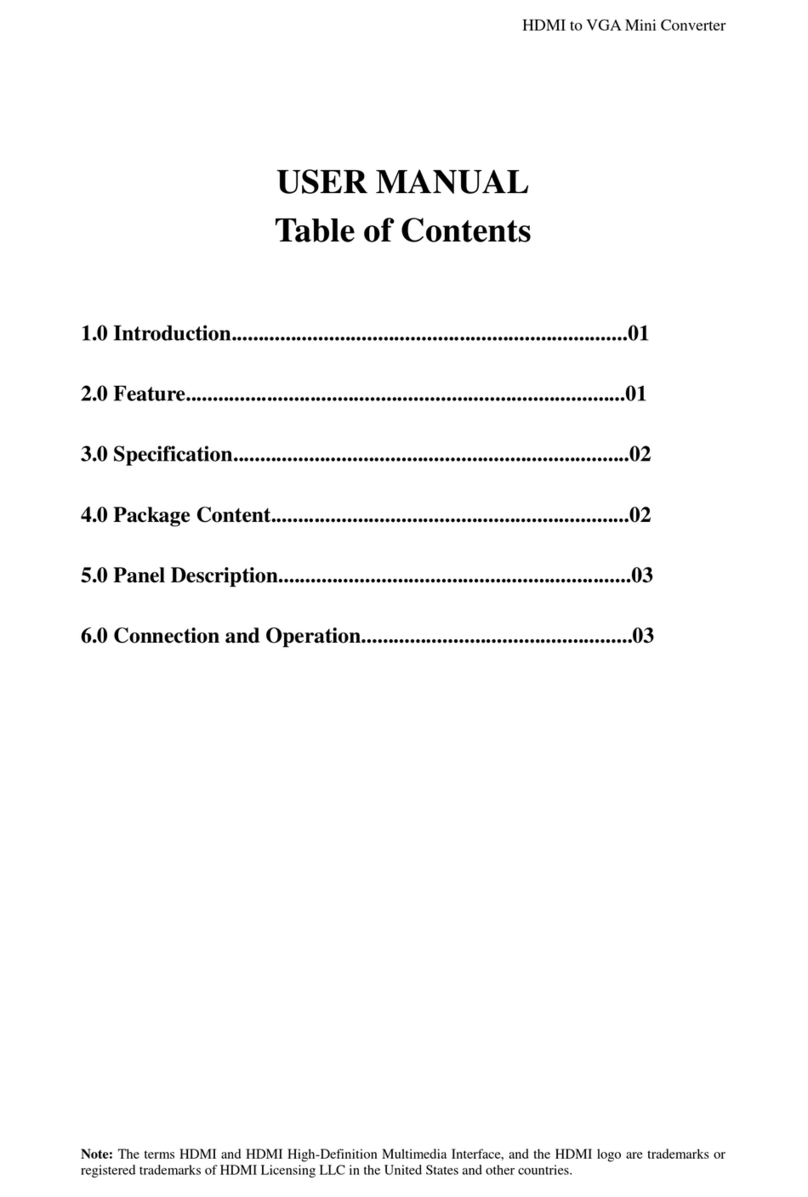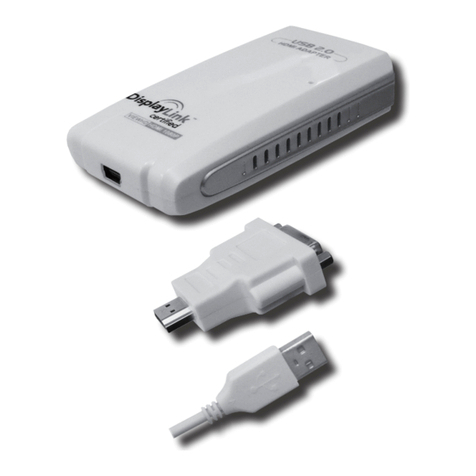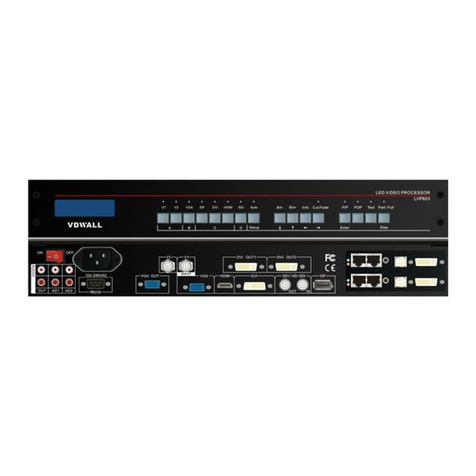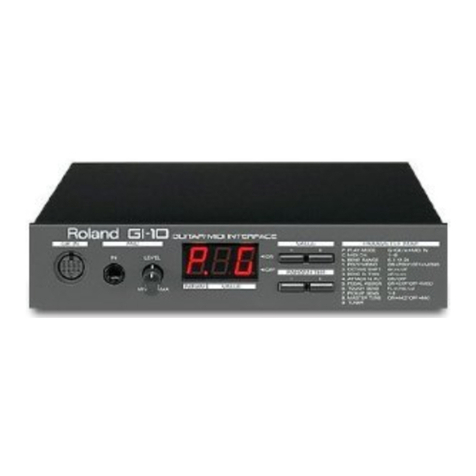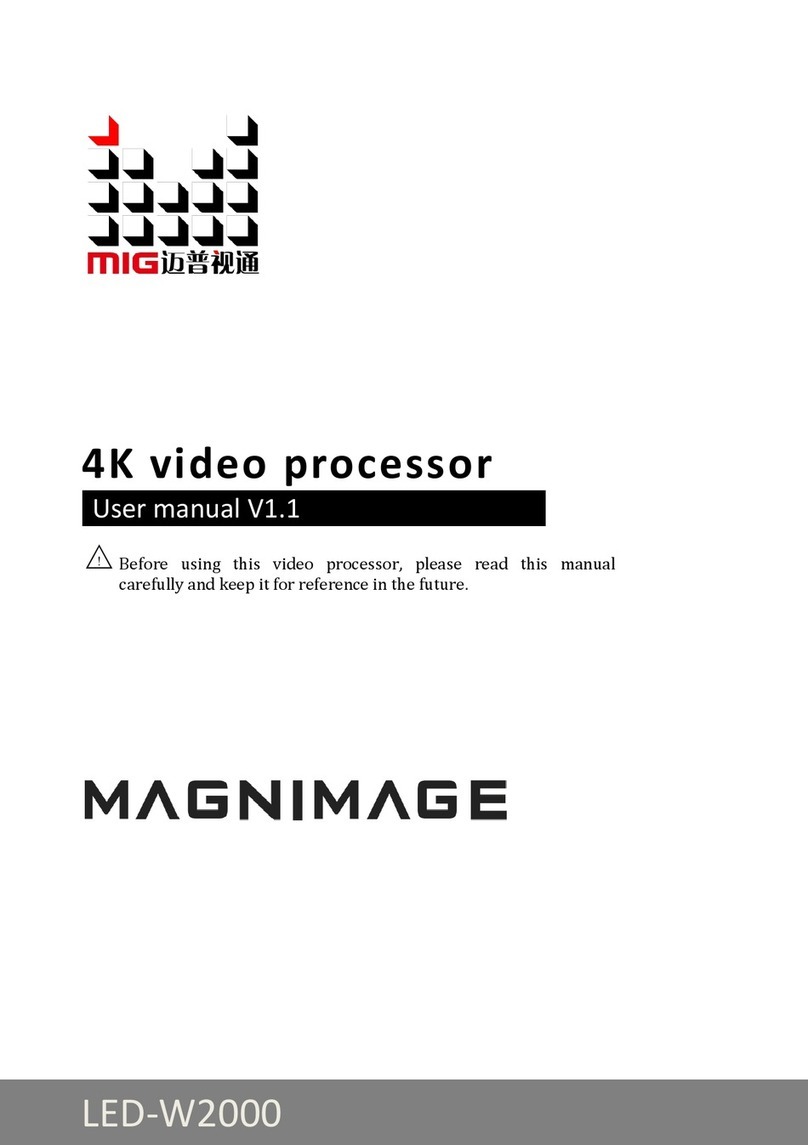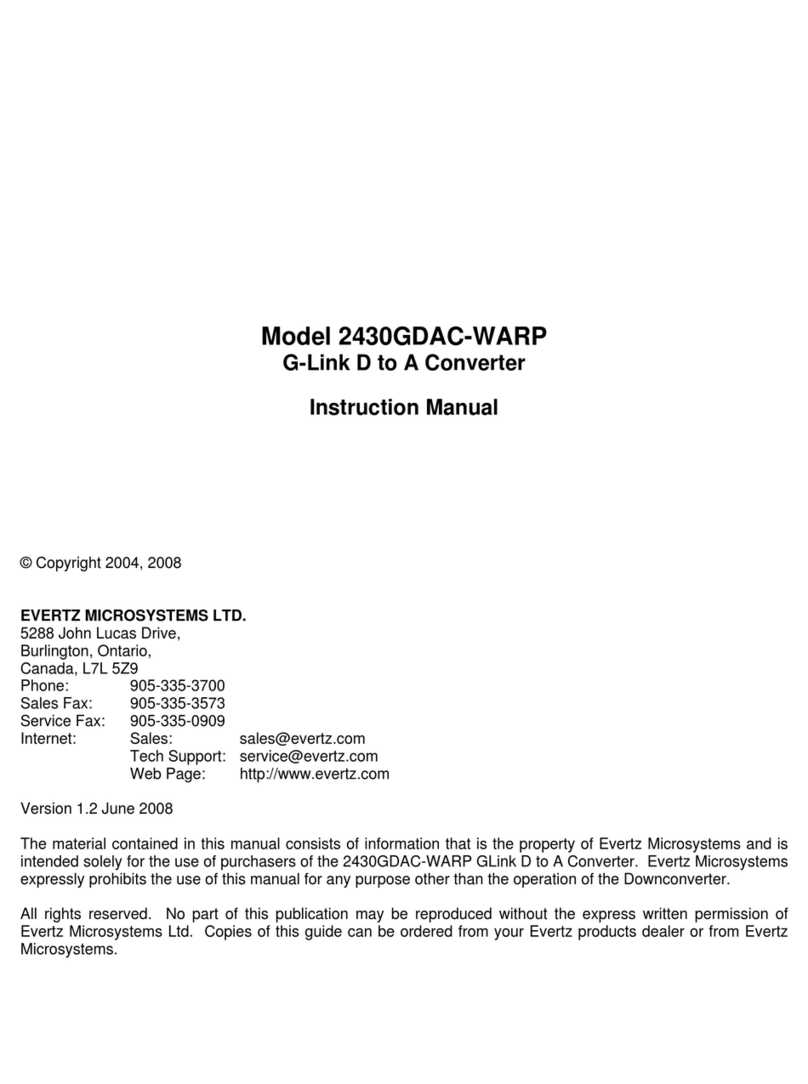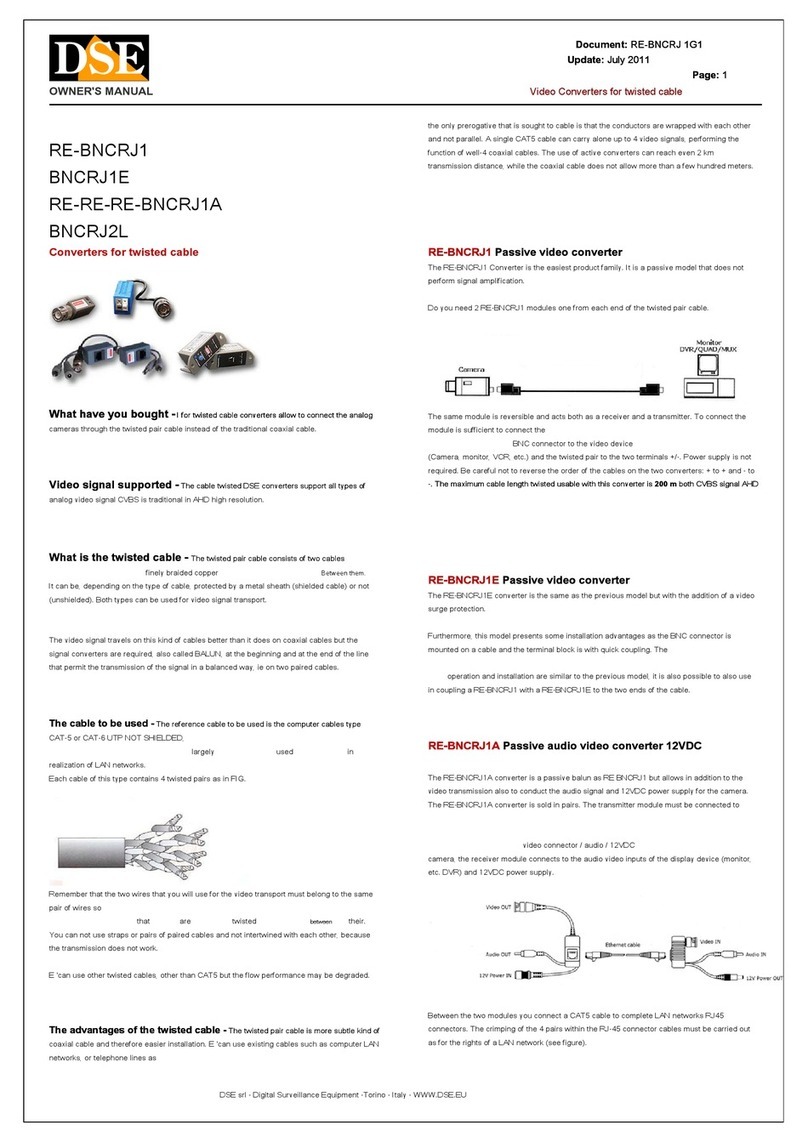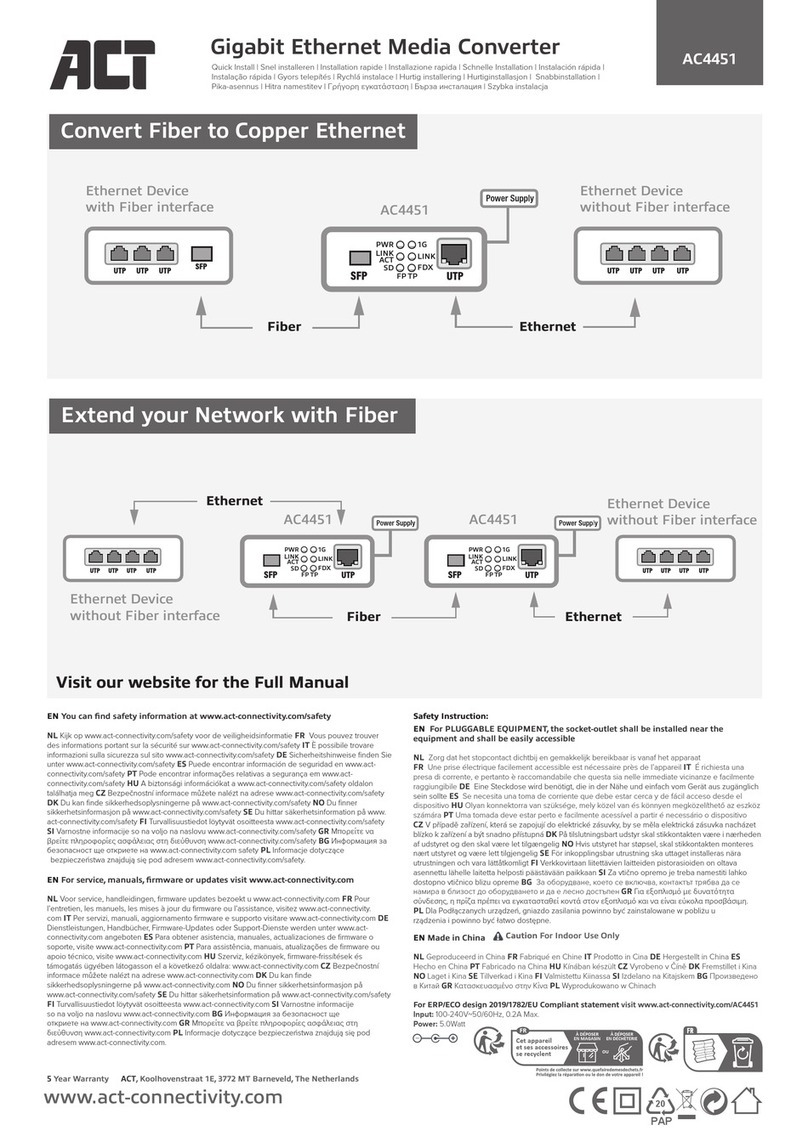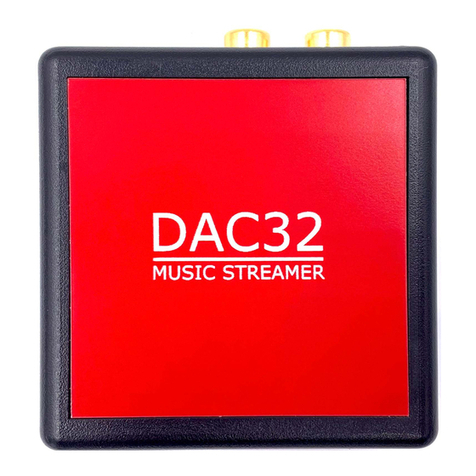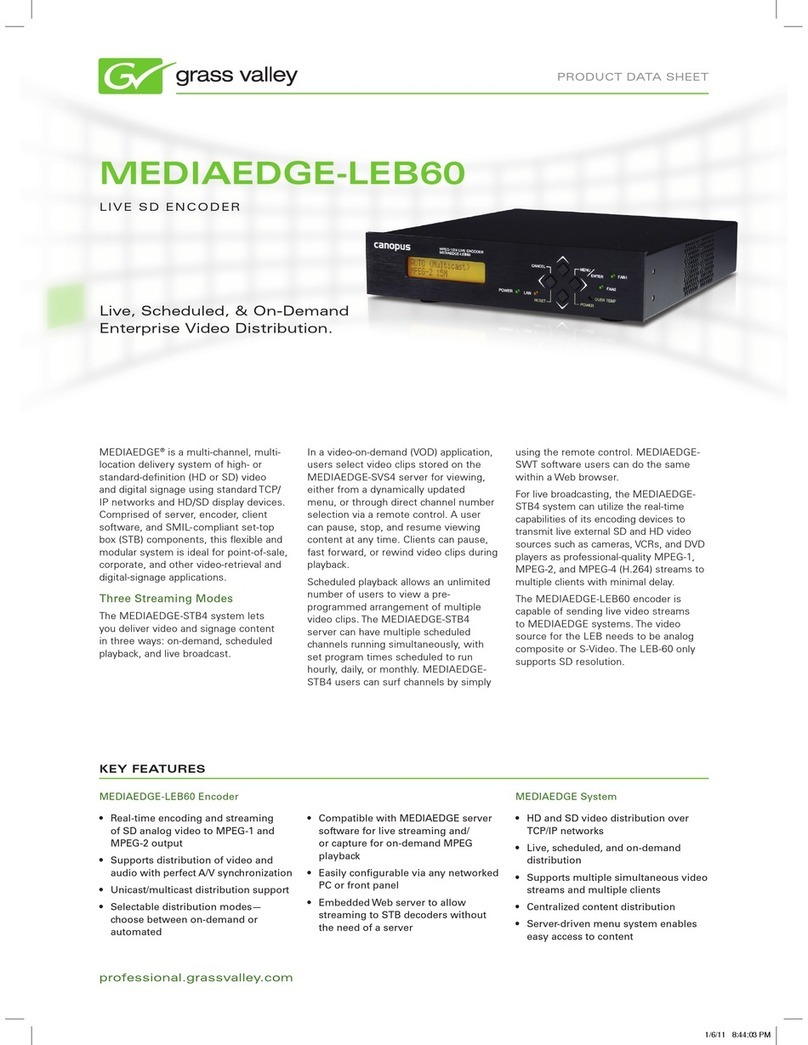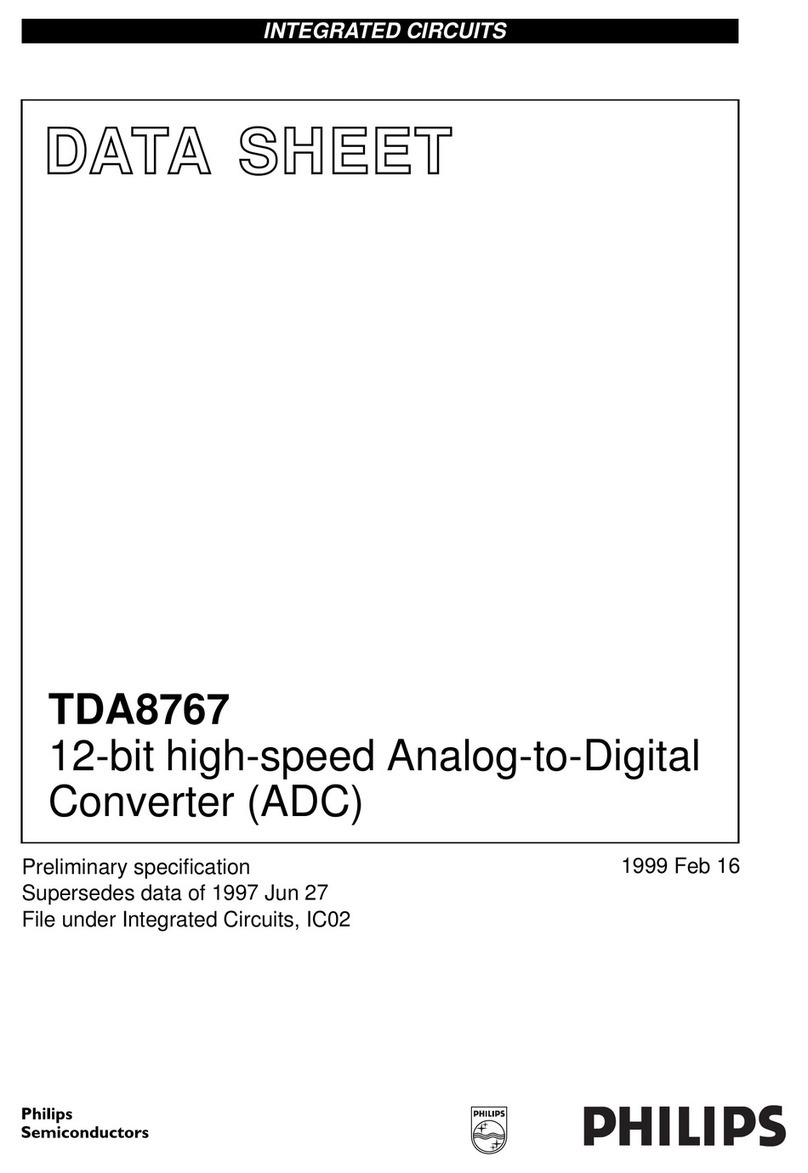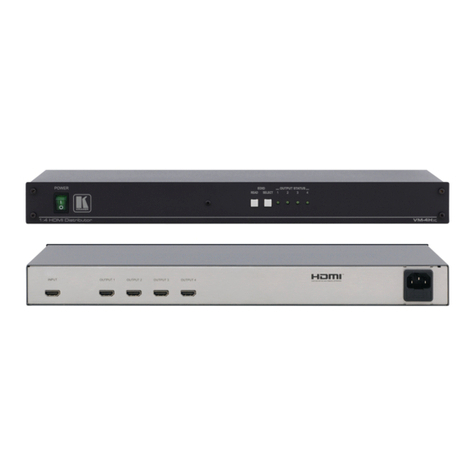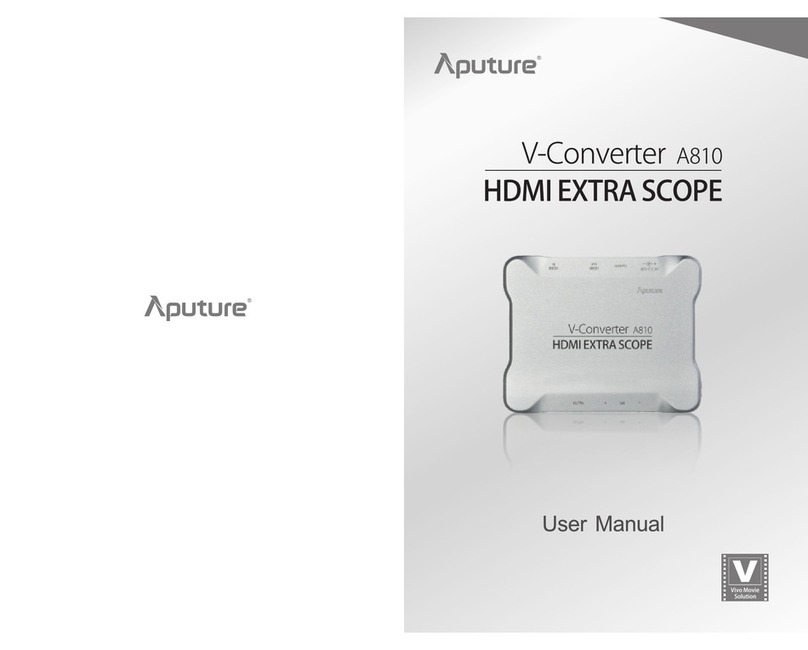Lavry AD122-96 Mark III User manual

Model AD122-96
Mark III
96kHz Mastering Quality Analog to Digital
Converter
Operations Manual
Lavry Engineering, Inc.
945 Hildebrand Lane NE
Suite 110
Bainbridge Island, WA 98110
(206) 842-3552
http://www.lavryengineering.com/
Revision 1.2
March 2005

Operations Manual AD122-96 MKIII
MKIII PREFACE
The MKIII is our 4th generation gold series analog to digital converter.
The first gold AD, model AD122 (developed under our old company name – dB Technologies)
was the first converter to reach 122dB dynamic range which is 20 bits of true performance.
While most AD converters specify dynamic range with an “A weighing” curve - a method which
reduces “the accountability” of lower and higher audio frequencies, Model AD122 provided a
122dB with no A weighing.
The second generation converter, The AD122-96 provided was an extension from the standard
44.1-48KHz sampling rate to “double speed” (88.2 and 96KHz sampling). The double speed
range dynamic range was lower then the standard range, and it was upgraded to the AD122
MKII.
The MKII provides 127dB dynamic range (without A weighing), and a consistent clean
performance over the frequency range. The much improved clock scheme provides extremely
low jitter with both internal and external lock. Achieving the state of the art performance
required increased usage of power, with much of it converted to heat. The MKII runs very hot,
which does reduce its reliability.
The MKIII is a redesign of the MKII, with a strong emphasis on heat reduction. The new
converter modules, housed in metal enclosures with massive heat sinks. A new MKIII
motherboard incorporates all of the previous MKII revisions and is powered by a new power
supply, with better control over DC voltages and power dissipation. The clock circuitry is the
same as the MKII. The software is very stable and left unchanged, therefore the features are all
identical to a MKII. The main benefit of much reduced heat is increased reliability. And last but
certainly not least, is the benefit from even lower distortions over the whole frequency range.
1

AD122-96 MKIII Operations Manual
LIMITED WARRANTY
Subject to the conditions set forth below, for one year after the original purchase date of the
product, Lavry Engineering will repair the product free of charge in the United States in the
event of a defect in materials or workmanship.
Lavry Engineering may exchange new or rebuilt parts for defective parts. Please call the factory
for an RMA number prior to shipment. No product will be accepted for warranty service
without a pre-issued RMA number.
This warranty is extended only to an original purchaser of the product from Lavry Engineering,
or an authorized reseller of Lavry Engineering. Products that are purchased from unauthorized
resellers do not have any warranty coverage. A valid purchase receipt or other valid proof of
purchase will be required before warranty service is provided. This warranty only covers
failures due to defects in materials or workmanship and does not cover damages which occur in
shipment or failures resulting from accident, misuse, line power surges, mishandling,
maintenance, alterations and modifications of the product, or service by an unauthorized service
center or personnel. Lavry Engineering reserves the right to deny warranty service to products
that have been used in rental, service bureau, or similar businesses.
This limited warranty gives you specific legal rights. You may have others which vary from
state/jurisdiction to state/jurisdiction.
LIMITS AND EXCLUSIONS
LAVRY ENGINEERING DOES NOT, BY VIRTUE OF THIS AGREEMENT, OR BY ANY
COURSE OF PERFORMANCE, COURSE OF DEALING, OR USAGE OF TRADE, MAKE
ANY OTHER WARRANTIES, EXPRESS OR IMPLIED, INCLUDING, WITHOUT
LIMITATION, ANY WARRANTY OF MERCHANTABILITY, FITNESS FOR A
PARTICULAR PURPOSE, TITLE OR NONINFRINGEMENT, AND ALL SUCH
WARRANTIES ARE HEREBY EXPRESSLY DISCLAIMED. LAVRY ENGINEERING
EXPRESSLY DISCLAIMS ANY IMPLIED INDEMNITIES. LAVRY ENGINEERING
SHALL NOT BE LIABLE FOR ANY INDIRECT, INCIDENTAL, CONSEQUENTIAL,
PUNITIVE, SPECIAL OR EXEMPLARY LOSSES OR DAMAGES, INCLUDING,
WITHOUT LIMITATION, DAMAGES TO RECORDINGS, TAPES OR DISKS, DAMAGES
FOR LOSS OF BUSINESS PROFITS, BUSINESS INTERRUPTION, LOSS OF BUSINESS
INFORMATION, LOSS OF GOODWILL, COVER, OR OTHER PECUNIARY LOSS,
ARISING OUT OF OR RELATING TO THE USE OF THE PRODUCT, OR ARISING FROM
BREACH OF WARRANTY OR CONTRACT, NEGLIGENCE, OR ANY OTHER LEGAL
THEORY, EVEN IF LAVRY ENGINEERING HAS BEEN ADVISED OF THE POSSIBILITY
OF SUCH LOSSES OR DAMAGES. ANY DAMAGES THAT LAVRY ENGINEERING IS
REQUIRED TO PAY FOR ANY PURPOSE WHATSOEVER SHALL NOT EXCEED THE
ORIGINAL COST PAID TO LAVRY ENGINEERING FOR THE APPLICABLE PRODUCT.
BECAUSE SOME STATES/JURISDICTIONS DO NOT ALLOW THE EXCLUSION OR
LIMITATION OF LIABILITY FOR CONSEQUENTIAL OR INCIDENTAL DAMAGES, THE
FOREGOING LIMITATION MAY NOT APPLY TO YOU.
Copyright © 2005 by Lavry Engineering, Inc. All rights reserved.
Lavry Engineering ® is a registered trademark of Lavry Engineering, Inc.
Acoustic Bit Correction™ is a registered Trademark of Lavry Engineering, Inc.
Internet: http://lavryengineering.com/
2

Operations Manual AD122-96 MKIII
Table of Contents
Limited Warranty ................................................................................. ..2
PART I
Introduction...........................................................................................4
Operating Instructions ..........................................................................5
Main Screen ..........................................................................................6
Word Length and Acoustic Bit Correction...........................................7
Test Tone Screen ..................................................................................7
Audio Control Screen ...........................................................................8
Default Parameters Screen....................................................................8
Bar Graph & Display Screen ................................................................9
Warm-up and Calibration .................................................................. 10
Hardware Interconnections................................................................ 11
Maintenance....................................................................................... 11
Part II
Specifications..................................................................................... 12
Appendix I
Acoustic Bit Correction™ ................................................................. 13
Noise-Shaping Curves ....................................................................... 16
Appendix II
AD122-96 MKIII Input Considerations ............................................ 17
Appendix III
AD122-96 MKIII Soft Saturation ..................................................... 19
Appendix IV
Viewing Noise Floor on AD122-96 MKIII Display ......................... 21
3

AD122-96 MKIII Operations Manual
4
PART I: Introduction
The Model AD122-96 MKIII Mastering Quality Analog to Digital Converter receives analog input
signals at the left and right analog input channels. The converter can receive balanced or unbalanced
analog input signals. Individual left and right analog gain adjustment can be achieved via the front panel
adjustment pots. Fine tuning of reference levels can be achieved by setting the front panel bar graph
display (LED's) to “Fine” mode (reference meter bridge). The digital output is available at the AES/EBU
output.
Front panel selection enables setting word length between 16 and 24 bits (NI is a 20 bit setting as per
AES/EBU specifications). The recommended normal setting for word length is 22-24 bits (the audio
content utilizes 22 bits). Lower bit settings are aimed at redithering using the available Acoustic Bit
Correction™ feature. Redithering to smaller words retains much of the acoustic information in the full
word width output.
The converter can operate with internal or external clock synchronization. Available internal crystal
frequencies are 44.1 kHz, 48 kHz, 88.2 kHz, or 96 kHz. For external synchronization, a signal is applied
to either the SYNC/WC input or the Word Clock input. The external synchronization parameters are
programmed into the converter according to desired frequency lock range and input type. The input types
are digital audio (AES/EBU) or word clock signals. The desired frequency lock range settings are
44.1 kHz narrow lock range, 48 kHz narrow lock range, 40-50 kHz wide lock range, 88.2 kHz narrow lock
range, 96 kHz narrow lock range, 88/44 kHz, or 96/48 kHz.
Vernier Transfer Function Correction™:
The exceptional performance of Lavry Engineering’s AD122-96 MKIII is due to design innovations in
both analog and digital sections. The high power consumption of the A/D modules, using high voltage
rails and high current, enables the use of discrete large geometry components. This provides advantages
from improved circuit architecture-- including class A amplifiers for fast settling and lower distortions,
and the use of low value resistors for lower noise.
The performance of the low-noise high-linearity converter is optimized by a set of proprietary algorithms
utilizing a "digital vernier" technique which provides superior resolution and correction for changes in
circuit parameters, including component drift due to temperature and aging.
Additional features:
Test Tones: a fully programmable digital test tone generator for calibration.
D.C. Removal: enables conversion of signals down to 0 Hz. D.C. removal is achieved by subtracting the
offset from the signal.
Polarity Inversion and Soft Saturation: for emulating analog tape saturation.
User-Defined Power-Up Default Setting
Stereophonic Bar Graph Display: features wide dynamic range; the bar graph can be extended by 30, 60
or 90dB for viewing the noise floor. The bar graph may also be altered for use as a reference meter
bridge.
Clip Indication: when digital full scale indication is enabled, the full scale “MAX” light holds until reset
by the user.
Format Control: pro or consumer data format. When in consumer mode the user can choose category,
C and L bit settings.

Operations Manual AD122-96 MKIII
5
Operating Instructions
Operation of the Model AD122-96 MKIII Mastering Quality Analog to Digital Converter requires
the use of five push button switches located on the front panel. The liquid crystal display is organized
for a quick and intuitive operator interface. The unit features six screen displays.
Push Button Switches:
ENTER Introduces and moves the cursor through screen positions that can be edited by the
operator.
CURSOR Push buttons allow the user to choose a screen and to select the cursor position. The
UP/DOWN cursor buttons are also utilized when changing digits of a selected entry.
GO Executes a command in Frequency selection, Test Tone, and Preset store.
EXIT Removes the cursor and allows selection of other screens with the UP/DOWN buttons.
Pressing EXIT again will cause the unit to go to the main screen.
To Scroll Through Screens:
If the screen cursor is present, you need to remove it by pressing EXIT. When the screen cursor is not
present, the UP/DOWN buttons serve to move from screen to screen.
To Edit Screens:
Press ENTER to introduce the screen cursor at the first editable location. Each additional pressing of
ENTER will move the cursor to the next editable location. The settings at an editable location may be
changed by the use of the UP/DOWN buttons.
Holding the UP or DOWN buttons will automatically advance the settings. This feature is particularly
useful for increasing or decreasing numbers (such as test tone frequency and amplitude or word
length).
Most operations react to a change of settings immediately without having to press GO. There are
three settings requiring the use of the GO button:
• Starting the test tone generator.
• Storing the user power-up default settings.
• Changing Sample Frequency Source.

AD122-96 MKIII Operations Manual
6
Main Screen
The main screen is used for selecting the A to D clock source and output word length parameters.
The top line controls the A to D clock source:
44.1kHz INTERNAL CRYSTAL
20 BITS WL ABC: FLAT NSOFF
When setting for internal clock operation, choose sample rate and internal crystal mode:
44.1kHz INTERNAL CRYSTAL
48kHz INTERNAL CRYSTAL
88.2kHz INTERNAL CRYSTAL
96kHz INTERNAL CRYSTAL
When setting for external synchronization, the selections include:
• Sync. input connector: SYNC/WC INPUT XLR connector or the WORD CLOCK INPUT BNC
connector.
• Digital audio or Word Clock: the XLR connector can accommodate both AES/EBU digital audio
data and Word Clock. The BNC connector is for Word Clock only, as part of the optional IO-96
interface.
• Lock range: narrow lock range utilizing VCXO (internal voltage controlled crystal oscillators or
wide lock range (internal low jitter VCO).
Possible choices for the SYNC/WC INPUT XLR connector are:
XLR AES LOCK 44.1 Phase synchronous
XLR AES LOCK 48.0 Phase synchronous
XLR AES WIDE LOCK Phase synchronous
XLR AES LOCK 88.2 Phase synchronous
XLR AES LOCK 96.0 Phase synchronous
XLR AES LOCK 88/44 Phase synchronous to 44.1
XLR AES LOCK 96/48 Phase synchronous to 48
Possible choices for the WORD CLOCK INPUT BNC connector are:
BNC LOCK 44.1 Phase synchronous
BNC LOCK 48.0 Phase synchronous
BNC WIDE LOCK Phase synchronous
BNC LOCK 88.2 Phase synchronous
BNC LOCK 96.0 Phase synchronous
BNC LOCK 88/44 Phase synchronous to 44.1
BNC LOCK 96/48 Phase synchronous to 48

Operations Manual AD122-96 MKIII
7
Word Length and Acoustic Bit Correction
The bottom line controls word length and Acoustic Bit Correction™ parameters:
44.1kHz INTERNAL CRYSTAL
20 BIT WL ABC: HPDF NS2
Setting Word Length:
The selection of word length (16 to 24 bits) sets the digital output word length. The NI setting (word
length not indicated) is a 20 bits default setting as per AES/EBU specifications. The Model AD122-
96 MKIII utilizes 22 bits for data (bits 23 and 24 contain little sonic information). We recommend a
default word length setting of 22-24 bits. The front panel "20+" lamp indicates when the output
contains 20 or more bits.
Acoustic Bit Correction™ is designed for applications requiring the use of fewer bits. Simple
truncation of lower order bits introduces sonic side effects (distortions and modulation of the noise
floor by the signal). The Acoustic Bit Correction™ feature provides a selection of dither and noise
shaping algorithms. Dither overcomes distortions and noise modulation, but it also raises the noise
floor. The noise shaping algorithms provide an effective means of retaining higher bit content in a
lower bit format (it shifts the noise energy away from hearing sensitive frequency regions to less
sensitive ones). See Appendix I for a complete discussion of Acoustic Bit Correction™.
Dither choices are:
OFF no dither
HPDF high pass probability density function
FLAT recommended for data compression applications
Noise shaping choices are:
NSOFF no noise shaping
NS1, NS2, NS3 or NS4 user selectable noise shaping curves
Test Tone Screen
To generate a test tone, scroll to the test tone screen and set the frequency, amplitude and destination
(let, right or both). The frequency range is from 1Hz to 20kHz in 1 Hz steps. Amplitude range is 0dB
(full scale) to -99dB in 1 dB steps, with an OFF setting for "digital black." To change the frequency or
amplitude by large increments, hold down the UP or DOWN cursor buttons. For small increments,
press the UP or DOWN cursor buttons repeatedly.
Press GO to start the tone (amplitude, frequency and destination settings may be changed during tone
generation). To stop the tone, press EXIT twice (returning to the main screen).
Note that the internal tone generation consists of 24 bits of resolution. The word length at the output is
subject to truncation and dither settings.

AD122-96 MKIII Operations Manual
8
Audio Control Screen
HIGH RESOLUTION MODE
DC REMOVAL: OFF +POLARITY
The user may activate the soft saturation feature by altering the top line to SOFT SATURATION
MODE.
When activated, the audio signal is amplified by two (6dB boost), and signal peaks are compressed
gently to avoid digital saturation. The feature emulates magnetic tape saturation.
DC offset removal:
The Model AD122-96 MKIII converts signals down to DC (0Hz). The total DC offset (due to DC
offset within the audio signal and the offset of the converter itself) can be removed. Removing the
offset sets the lower line to DC REMOVAL ON.
DC removal should be activated prior to processing of audio, to allow for some settling time (less then
3 seconds) and to avoid a "click" sound. The algorithm continues to monitor and correct for slow
varying offset variations.
Polarity:
+POLARITY corresponds to analog input signal connection with "pin 3 hot". -POLARITY
corresponds to analog input signal connection with "pin 2 hot".
Note that polarity reversal works for both balanced and unbalanced analog input signals. The analog
inputs (XLR connectors) are physically wired for "pin 3 hot" phase. Activating polarity reversal is
done digitally (after the conversion).
Default Parameters Screen
The Model AD122-96 MKIII recalls its power-up default settings from a nonvolatile memory (RAM).
To change the default settings scroll to the RAM PRESET screen:
STORE RAM PRESET:
(PRESS GO/EXIT)
Then press the GO button. The new default settings storage is done and the display changes to:
STORE RAM PRESET:
DONE...

Operations Manual AD122-96 MKIII
9
Bar-Graph & Display Screen
FINE: OFF 20 METER: -00 0
PEAK/HOLD OFF DISPLAY:4
Bar-Graph settings:
FINE: OFF sets the bar graph display (LED's) for normal audio monitoring. Setting to FINE: ON 20
activates the reference meter bridge function, for fine-tuning of signal level to -20dB reference point.
The reference point can be set to a level between -10dB and -20dB. The incoming signal is displayed
in 0.2dB increments around the reference point. Fine-tuning of signal levels may be done via an
external volume control or by tuning the GAIN adjustment pots located on the front panel (the
adjustment requires a small screwdriver).
The normal setting, “METER:-00” is used for showing peak and peak-hold levels ranging from 0 to -
55dB (from full scale). The display may be extended to indicate lower level activity such as noise and
DC offset.
Meter Setting Display range Read Bar-Graph
METER:-00 0dB to -55dB Read Bar Graph panel indicator
METER:-30 -30dB to -85dB Add -30dB to panel indicator
METER:-60 -60dB to -115dB Add -60dB to panel indicator
METER:-90 -90dB to -145dB Add -90dB to panel indicator
While this feature is useful for determining noise floor of the incoming signal, a few comments are in
order:
1. The Bar Graph displays a sum of AC signal "riding" on a DC offset. Monitoring low-level signals
(such as noise floor) requires prior setting of DC removal at the audio control screen DC
REMOVAL ON.
2. Viewing the noise floor takes some getting used to. The display shows a true picture of peak and
peak-hold information; the blinking of LED's is due to low level quantizations. Peak readings are
at about 11dB higher than the rms noise for flat noise spectrum.
3. Measuring the converter noise floor is best done with specialized equipment (such as Lavry
Engineering’s Model 3000). To verify the proper converter noise floor via extended metering you must
activate the DC removal (DC REMOVAL ON) and connect a low value resistor (0-1KOhm) between
pins 2 and 3 of the analog input XLR connector. Floating high impedance analog inputs are susceptible
to noise pickup.
Data limiting settings:
The symbol 0(low) on the top line, “FINE:OFF 20 METER: -00 0”indicates that the AD122-96
MKIII passes full-scale values unchanged. The symbol 1indicates that full-scale values are limited to
1 least-significant bit less than full scale. In this mode downstream machines will not show overs.
This bit is stored in the programmable preset. The factory default is 0(off).
Peak/Hold indication:
When set to ON, the peak level is held until a front panel switch is depressed. In addition, the “MAX”
LED will turn on and stay on when output data hits the full-scale value. The appropriate 0dB bar-graph
lamp (left or right) will start blinking. The “MAX” and corresponding lamps may be reset by pressing

AD122-96 MKIII Operations Manual
10
any of the front panel switches. When PEAK/HOLD is OFF, the MAX lamp will flicker when a single
full-scale sample is encountered.
Display contrast: The LCD display may be adjusted from 0 to 7.
Warm-up and Calibration
The recommended warm up time is 15 minutes. The unit features automatic calibration. A complete
calibration cycle (about 5 seconds in duration) is activated at power on. A calibration cycle may be
done by pressing both the EXIT and GO buttons simultaneously.

Operations Manual AD122-96 MKIII
11
Hardware Interconnections
Analog inputs are applied to the XLR connectors marked as LEFT ANALOG INPUT and RIGHT
ANALOG INPUT. The input signals can be balanced or unbalanced. The converter power line signal
rejection is very high (120dB common mode rejection) but use of high quality shielded audio cables is
recommended.
The digital output AES/EBU connector (XLR) provides transformer coupled output for both
AES/EBU and consumer formats.
SYNC\WC INPUT (XLR connector) is used for external synchronization to digital audio or to a word
clock synchronization source.
The four BNC connectors provide channel one and channel two data, word clock out, and word clock
in. They can be used for synchronizing additional converters to each other or an external TTL word
clock.
Maintenance
The Model AD122-96 MKIII is an auto calibrating converter requiring no periodic adjustments. The
unit's reliance on linear power supplies and discreet class A analog circuitry generates significant
amount of heat (25 watts maximum). The temperature rise is no cause for concern, but allowing for
some airflow is always a benefit from a long-term reliability standpoint.
The front panel is gold plated (24 karat gold). Use a soft cloth (and plain water, if necessary) to clean
fingerprints.

AD122-96 MKIII Operations Manual
12
Part II: Specifications
Analog Inputs:
The analog signal can be amplified by 0-12dB utilizing the front panel screw adjust trim pots. Full-
scale signal with 0dB gain is 24dBu, (full-scale signal with 12dB gain is 12dBu).
Input impedance over 0-100 kHz: greater than 20k ohm (pin 2 to pin 3).
Noise Floor at 44.1-48KHz sampling:
-130dB ±1dB from full scale A weighted
-126dB ±0.5dB from full scale unweighted
Noise Floor at 96KHz sampling:
-127dB ±1dB from full scale A weighted
-123dB ±1dB from full scale unweighted.
Notes:
1. Measuring noise floor with unconnected (opened) inputs may yield erroneous results.
Unconnected high impedance inputs may pick up unwanted signals.
2. Care must be exercised when measuring the noise floor. The signal applied to the converter
must be lower then the noise floor. Ordinary relays and switches may leak too much signal, and it
may be necessary to move a test tone signal to frequency above Nyquist (approx. 30KHz).
Output Bits: 16 to 24 bits, user selectable.
Total Harmonic Distortion and Noise:
(Specified for 22-24 Bits output, balanced inputs)
0.00005% for signals lower than -40dBF
0.0004% for signals lower than -20dBF
0.0008% for signals lower than -6dBF
0.0012% for full scale signals
Channel Separation:
Greater than 120dB (0-20KHz)
Sync. Inputs:
XLR connector: AES/EBU levels into 110 Ohms for digital audio TTL level into 110 Ohms word
clock
BNC connector: TTL level word clock

Operations Manual AD122-96 MKIII
Appendix I: Acoustic Bit Correction™
High quality digital audio sound often incorporates long words (many bits). Both high-resolution A/D
converters (22 bits or more) and signal processing equipment (digital mixers, equalizers, reverb and
more) generate longer words than those supported by standards (such as the 16-bit CD format). A
straightforward word length reduction severely deteriorates the musical fine detail of low level signals
by introducing distortions and a noise floor that is modulated by the signal.
Proper dithering serves to eliminate the distortions and noise modulation effects. The desirability of
such improvement is unquestionable but is coupled with increasing noise floor. Noise shaping is based
on shifting the noise from high sensitivity frequency regions to less sensitive ones. That process is
based on psychoacoustic research. A "stand alone" noise shaper does not improve distortions and noise
modulation problems. Lavry Engineering’s Acoustic Bit Correction incorporates both concepts to
reduce distortion and noise modulation and shape the noise psychoacoustically.
Customer feedback and further studies taught us two interesting facts:
a. Various data compression schemes require the dither to have flat frequency response
characteristics.
b. Recording engineers’ preference of dither type (high pass or flat) and noise shaping curves
often depends on characteristics of the music involved.
The Model AD122-96 MKIII offers High Pass or Flat Dither type and four noise-shaping curves.
Model AD122-96 MKIII allows the user to use dither with or without noise shaping. Operating noise
shapers without dither is undesirable so the unit automatically shuts the noise shaper off when dither is
off. Using dither (with or without noise shaping) requires user discretion. Ideal data transfer and
processing should retain long word length. A single word length reduction (and therefore dithering and
noise shaping) should take place last.
Figure 1 shows a -100 dB 1 kHz 24 bit tone truncated to 16 bits. The distortion is severe. Figure 2
shows the same tone with high-pass dither only. The distortion is gone, and the tone’s level appears at
a true -100 dB. Figure three shows the same tone with Acoustic Bit Correction™ applied. Notice
what the addition of noise shaping to the dither does to the noise floor in the ear’s most sensitive mid-
range area (approx. 2kHz to 8 kHz).
20.00 2.02k 4.02k 6.01k 8.01k 10.0k 12.0k 14.0k 16.0k 18.0k 20.0k
FREQ(Hz)
-150.0
-145.0
-140.0
-135.0
-130.0
-125.0
-120.0
-115.0
-110.0
-105.0
-100.0
AMP1(dBFS)
AUDIO PRECISION FFT vs 13 NOV 93 20:05:49
20.00 2.02k 4.02k 6.01k 8.01k 10.0k 12.0k 14.0k 16.0k 18.0k 20.0k
FREQ(Hz)
-150.0
-145.0
-140.0
-135.0
-130.0
-125.0
-120.0
-115.0
-110.0
-105.0
-100.0
AMP1(dBFS)
AUDIO PRECISION FFT vs 13 NOV 93 20:02:38
20.00 2.02k 4.02k 6.01k 8.01k 10.0k 12.0k 14.0k 16.0k 18.0k 20.0k
FREQ(Hz)
-150.0
-145.0
-140.0
-135.0
-130.0
-125.0
-120.0
-115.0
-110.0
-105.0
-100.0
AMP1(dBFS)
AUDIO PRECISION FFT vs 13 NOV 93 20:04:55
Fig. 1- truncation only Fig. 2 - high-pass dither Fig. 3 - Acoustic BitCorrection
High Pass- NS2
A number of mathematical and psychoacoustic researchers introduced two concepts for sonic
improvement: dithering and noise shaping. Credit is due to L. Fielder of Dolby Labs for providing the
basis for various noise shaping curves. The reasons for triangle PDF (probability density function)
dither have been explained by S. P. Lipshitz and J. Vanderkooy of the University of Waterloo.
13

AD122-96 MKIII Operations Manual
Additional publications by M. Gerzon, P. G. Craven, J. R. Stuart and J. R. Wilson (all from the United
Kingdom) and J. Goodwin (from the U.S.A.) shed light on this complex subject.
Dithered noise shaping technology has been incorporated into a handful of hardware devices. While all
are based on the same concepts, some perform better than others. After simulating and listening to all
available public domain algorithms, Lavry Engineering came to some conclusions in forming a basis
for Acoustic Bit Correction™. The principal conclusions are:
a. The practice of greatly amplifying low level signals to determine triangular flat PDF (probability
density function) dither reveals the effectiveness of distortion and noise modulation elimination. This
practice yields misleading results when testing unflattened dithers and/or noise shapers. It conflicts
directly with L. Fielder’s findings showing completely different threshold delectability curves for quiet
and loud levels. Noise shaping listening tests must be done at "reasonable" volume levels.
b. Given the above requirement, our listening tests concluded a strong preference for "triangle high
pass" dither (this dither is produced by simultaneously adding a new random number and subtracting
the previous value). Such dither is frequency-shaped to carry more high frequency energy (the energy
content at low frequencies is minimal).
c. Listening tests revealed a preference for smoothly varying noise-shaping curves. Peaks and notches
seem to irritate the listener (admittedly while turning the volume up). In addition, despite the
temptation to optimize the noise shaping curve to the average listener’s hearing threshold, given a
significant variation from listener to listener requires reasonable compromises in tailoring such a
curve. In other words, smooth the curve.
The improvements offered by dither and noise shaping vary with source material and final word
length. An A/B/X test at 16-bit level, requires a quiet environment and low level (loudness) audio. The
listener must resist the temptation to turn the volume up to unreasonable levels. The practice of
truncating to short word length (8-12 bits) should be avoided. The ideal noise-shaping curve may be
irritating at loud levels.
Lavry Engineering’s listening tests were based on test tones and repeating loops of quiet passages of
various material (mostly classical music) with flat amplifier response. Listening to test tones was
straightforward: we used the Model AD122-96 MKIII test tone generator mode switching the
Acoustic Bit Correction™ on and off. The frequency and amplitude programmability was very useful.
20.00 2.02k 4.02k 6.02k 8.01k 10.0k 12.0k 14.0k 16.0k 18.0k 20.0k 22.0k 24.0k
FREQ(Hz)
-180.0
-175.0
-170.0
-165.0
-160.0
-155.0
-150.0
-145.0
-140.0
-135.0
-130.0
-125.0
-120.0
-115.0
-110.0
-105.0
-100.0
AMP1(dBFS)
AUDIO PRECISION FFT vs 14 NOV 93 12:54:19
20.00 2.02k 4.02k 6.02k 8.01k 10.0k 12.0k 14.0k 16.0k 18.0k 20.0k 22.0k 24.0k
FREQ(Hz)
-180.0
-175.0
-170.0
-165.0
-160.0
-155.0
-150.0
-145.0
-140.0
-135.0
-130.0
-125.0
-120.0
-115.0
-110.0
-105.0
-100.0
AMP1(dBFS)
AUDIO PRECISION FFT vs 14 NOV 93 12:47:26
20.00 2.02k 4.02k 6.02k 8.01k 10.0k 12.0k 14.0k 16.0k 18.0k 20.0k 22.0k 24.0k
FREQ(Hz)
-180.0
-175.0
-170.0
-165.0
-160.0
-155.0
-150.0
-145.0
-140.0
-135.0
-130.0
-125.0
-120.0
-115.0
-110.0
-105.0
-100.0
AMP1(dBFS)
AUDIO PRECISION FFT vs 14 NOV 93 12:45:07
Fig. 4 - Acoustic Bit Correction™ Fig. 5 - ABC HP-NS2 Fig. 6 - dither only
16 (top), 18, 20, and 22 bits 16 (top), 18, 20, and 22 bit 16 (top), 18, 20, and 22 bits
no input signal -120 dB 1 kHz sine tone -120 dB 1 kHz sine tone
Acoustic Bit Correction™ may be used with words of lengths wider than 16 bits. Figure 4 shows the
noise floor of Acoustic Bit Correction™ (High Pass, NS2) without a signal at 16, 18, 20, and 22 bit
wordlengths. Note the curved noise-floor with lowest level in the ear’s most sensitive mid-range
region.
Figure 5 shows Acoustic Bit Correction™ (High Pass, NS2) applied to a 24 bit input, reducing to 16,
18, 20, and 22 bit output widths. Notice that there is no noise modulation present.
14

Operations Manual AD122-96 MKIII
Figure 6 shows the effect of high-pass triangular dither only. The more coherent data in the dithered
bits, the better the dithering process works. Note that dithering from 24 bits to 22 bits has a lower noise
floor but more visible distortion components than dithering to a shorter word length, due to fewer bits
in the portion of the word being truncated.
20.00 2.02k 4.02k 6.02k 8.01k 10.0k 12.0k 14.0k 16.0k 18.0k 20.0k 22.0k 24.0k
FREQ(Hz)
-170.0
-165.0
-160.0
-155.0
-150.0
-145.0
-140.0
-135.0
-130.0
-125.0
-120.0
-115.0
-110.0
-105.0
-100.0
-95.00
-90.00
-85.00
-80.00
AMP1(dBFS)
AUDIO PRECISION FFT vs 14 NOV 93 15:50:12
20.00 2.02k 4.02k 6.02k 8.01k 10.0k 12.0k 14.0k 16.0k 18.0k 20.0k 22.0k 24.0k
FREQ(Hz)
-170.0
-165.0
-160.0
-155.0
-150.0
-145.0
-140.0
-135.0
-130.0
-125.0
-120.0
-115.0
-110.0
-105.0
-100.0
-95.00
-90.00
-85.00
-80.00
AMP1(dBFS)
AUDIO PRECISION FFT vs 14 NOV 93 13:58:03
Fig. 7- 16 bit input signal -100 dB Fig. 8- 16 bit input signal -100 dB
truncation by previous processing additional processing and truncation
Should dither be applied to input signals of 16 bit word length? Figure 7 shows a -100 dB tone of 16
bit word width with no dither or noise shaping. Note the presence of all of the odd harmonics, created
when the truncation process turned the tone into a 1 lsb square wave. Figure 8 shows the result of
applying additional processing to this signal, and truncating the result, thereby creating additional
distortion components.
20.00 2.02k 4.02k 6.02k 8.01k 10.0k 12.0k 14.0k 16.0k 18.0k 20.0k 22.0k 24.0k
FREQ(Hz)
-170.0
-165.0
-160.0
-155.0
-150.0
-145.0
-140.0
-135.0
-130.0
-125.0
-120.0
-115.0
-110.0
-105.0
-100.0
-95.00
-90.00
-85.00
-80.00
AMP1(dBFS)
AUDIO PRECISION FFT vs 14 NOV 93 13:59:14
20.00 2.02k 4.02k 6.02k 8.01k 10.0k 12.0k 14.0k 16.0k 18.0k 20.0k 22.0k 24.0k
FREQ(Hz)
-170.0
-165.0
-160.0
-155.0
-150.0
-145.0
-140.0
-135.0
-130.0
-125.0
-120.0
-115.0
-110.0
-105.0
-100.0
-95.00
-90.00
-85.00
-80.00
AMP1(dBFS)
AUDIO PRECISION FFT vs 14 NOV 93 14:00:12
Fig. 9-
16 bit input signal -100 dB Fig. 10- 16 bit input signal -100 dB
high pass dither applied Acoustic Bit Correction applied
Figure 9 shows the original 16 bit input signal processed with high-pass dither only. Notice that the
additional distortion is gone. Figure 10 shows Acoustic Bit Correction™ (dither and noise-shaping)
applied to the same signal with an increase in the effective noise floor. Acoustic Bit Correction™
cannot remove truncation distortion in an incoming 16 bit signal, but it can avoid additional truncation
distortion if additional processing, such as sample rate conversion, has been applied.
15

AD122-96 MKIII Operations Manual
Noise-Shaping Curves
20.00 2.02k 4.02k 6.01k 8.01k 10.0k 12.0k 14.0k 16.0k 18.0k 20.0k
FREQ(Hz)
-160.0
-155.0
-150.0
-145.0
-140.0
-135.0
-130.0
-125.0
-120.0
-115.0
-110.0
-105.0
-100.0
-95.00
-90.00
-85.00
-80.00
AMP1(dBFS)
AUDIO PRECISION FFT vs 26 JUN 94 14:42:15
NS4
NS3
NS2
FLAT
Fig. 11- 1kHz input signal -100 dB
Flat dither, with multiple noise-shapers shown
Figure 11 compares Flat dither
with NS2, NS3, and NS4 noise-
shaping curves. Note the
increasing aggressiveness of the
curves, with the pronounced dip
at 4kHz and in the 12kHz region.
These correspond to the most
sensitive areas of the ear to
noise.
Quantization noise is shifted
from these areas to high
frequencies, where the ear is
less sensitive.
Noise-shaping curves should be
selected based upon listening
tests of specific material to be
dithered.
20.00 2.02k 4.02k 6.01k 8.01k 10.0k 12.0k 14.0k 16.0k 18.0k 20.0k
FREQ(Hz)
-160.0
-155.0
-150.0
-145.0
-140.0
-135.0
-130.0
-125.0
-120.0
-115.0
-110.0
-105.0
-100.0
-95.00
-90.00
-85.00
-80.00
AMP1(dBFS)
AUDIO PRECISION FFT vs 26 JUN 94 14:37:38
NS4
NS3
NS2
HPDF
Fig. 12- 1kHz input signal -100 dB
HPDF dither, with multiple noise-shapers shown
Figure 12 compares High Pass
dither with NS2, NS3, and NS4
noise-shaping curves. High
Pass dither gives more noise
shaping in the high-frequency
band, while slightly lowering low
frequency quantization.
Note: in Figures 11 and 12, NS1
curve has been omitted for
clarity. It lies below NS2.
16

Operations Manual AD122-96 MKIII
17
Appendix II: AD122-96 MKIII Input Considerations
Achieving 20 or more bits of resolution places a heavy demand on the linearity and noise of analog
signals prior to the A/D conversion.
Linearity: Linearity problems (typically associated with larger signals) should be avoided to prevent
overall signal distortions. Proper circuit design places non-linear devices inside a negative feedback
path, thus allowing the transfer function to depend on a few linear components (such as resistor ratio).
Closer examination reveals that the effectiveness of negative feedback is limited by the open loop gain
of the amplifier (the available gain prior to the feedback action). Constructing a 10dB gain stage out
of, say, a 50dB open loop amplifier provides 40dB of feedback; thus, circuit nonlinearities are
corrected for by a factor of 100. A 1% nonlinearity reduces to a .01% level. The same stage, when set
to a gain of 20dB, yields only 50-20=30dB of "linearizing power"; thus the same 1% circuit
nonlinearity is corrected to 1/31.6 = .03%. The "obvious" solution of increasing circuit open loop gain
is riddled with problems ranging from impulse response settling time to loss of bandwidth.
Noise: The quantization (A/D conversion) of analog noise causes loss of fine signal detail. The
quantized noise introduces time varying signal dependent distortions. Such sample by sample
deviation can not be compared to the seemingly "constant" analog background noise. The interaction
between the noise and the quantization process effects the sonic detail at much higher amplitude than
the noise level itself. The source material may have its own noise level, but the A/D manufacturer is in
no position to decide which part of the material is signal and which part is noise. (Is it undesirable
noise or is it the intentional recording of the wind blowing through the trees?) Thus, any signal must be
reproduced accurately. All we can do, and all we should do amounts to avoiding additional A/D noise.
A/D noise consists of two parts: analog noise (prior to quantization), and quantization noise. The
quantization noise level is "fixed" by the converter itself. Model AD122-96 MKIII quantization noise
relative full scale is about 126dBFS. Keeping complete system noise level at 126dBFS requires careful
treatment of the analog path. Each circuit component (especially resistors and semiconductors)
generates its own noise. The complex electron motion within the various materials adds up to a
cumulative noise. Intentional amplification of signals yields undesirable amplification of noise. Once
again, each dB of added gain takes away a dB from the available dynamic range.
AD122-96 MKIII Input Range: You may suspect by now that our aim is to provide you with an A/D
converter and leave the problem of providing a "hot" signal at the hands of microphone and mic-
preamplifier manufacturers. Like many A/D's, Model AD122-96 MKIII provides limited gain (0-
12dB). There are 4 methods for analog input signal interconnection:
1. Balanced/ grounded shield
2. Balanced/ floating shield
3. Unbalanced/ grounded shield
4. Unbalanced/ floating shield.
Grounded shield: analog cable shield is connected pin 1 of the XLR at both ends of the cable driver
end and A/D end.
Floating shield: analog cable shield is connected pin 1 of the XLR only at the driver end of cable. The
shield is floating at the A/D side (not connected to pin 1).

AD122-96 MKIII Operations Manual
18
Note: Much information is available regarding proper shielding. The well known book "Grounding
And Shielding in Instrumentation" by Ralph Morrison provides an excellent explanation of the subject
and points out clearly that the floating shield connection is the correct configuration. Engineers using
the grounded configuration with 16-17 bit systems may wish to re-evaluate their interconnections for
20 bit systems.
1. Balanced input with floating shield: The unit handles up to 24dBu of peak signal with available 0-12
dB of front panel gain adjustment.
2. Balanced input with grounded shield: The unit handles up to 24dBu of peak signal with available 0-
12 dB of front panel gain adjustment
3. Unbalanced input with floating shield: The unit handles up to 24dBu of peak signal with available 0-
8 dB of front panel gain adjustment
4. Unbalanced input with grounded shield: The unit handles up to 24dBu of peak signal. The front
panel gain range is 0-8 dB.
Comments: The first three configurations operate over the same range. Little attenuation is required in
processing of a 24dBu signal (34.72V peak to peak) with our +/- 17.5V supply rails.
When applying unbalanced signals, use at least 4 dB of gain, using the gain adjustment pots located on
the front panel.

Operations Manual AD122-96 MKIII
Appendix III: AD122-96 MKIII Soft Saturation
The SOFT SATURATION feature provides a digital emulation of an ideal magnetic tape saturation
characteristic. The three available settings are:
1. SOFT SATURATION OFF: yields normal converter operation (see lower curve VOFF).
2. SOFT SATURATION +3dB: provides a digital gain of 3dB for sample amplitudes below
-6dBFS and digital compression for amplitudes greater then -6dBFS (see middle curve V3dB).
3. SOFT SATURATION +6dB: provides a digital gain of 6dB for sample amplitudes below
-12dBFS and digital compression for amplitudes greater then -12dBFS (see upper curve 6dB).
The graph below shows the three transfer functions. The plots show input versus output value between
-20dBFS and 0dBFS.
The algorithm for soft saturation is fundamentally different from classical audio compression. A
compression algorithm provides time varying gain as a function of signal power. The gain variations
are slowed down (attack and decay envelopes) to minimize distortions (a sudden step in signal gain
generates a time decaying distortion).
The soft saturation algorithm operates on a sample by sample basis. All sample values below a given
threshold (-6dBFS or -12dBFS) are amplified by a constant gain (+3dB or +6dB) and all sample values
above the threshold are reduced by a pre-assigned amount emulating ideal tape magnetization curve
(exponential function). While signal peaks get "pushed down" (peak signal distortions), the dynamic
performance for signals under the selected threshold stays intact.
19
Table of contents
Other Lavry Media Converter manuals
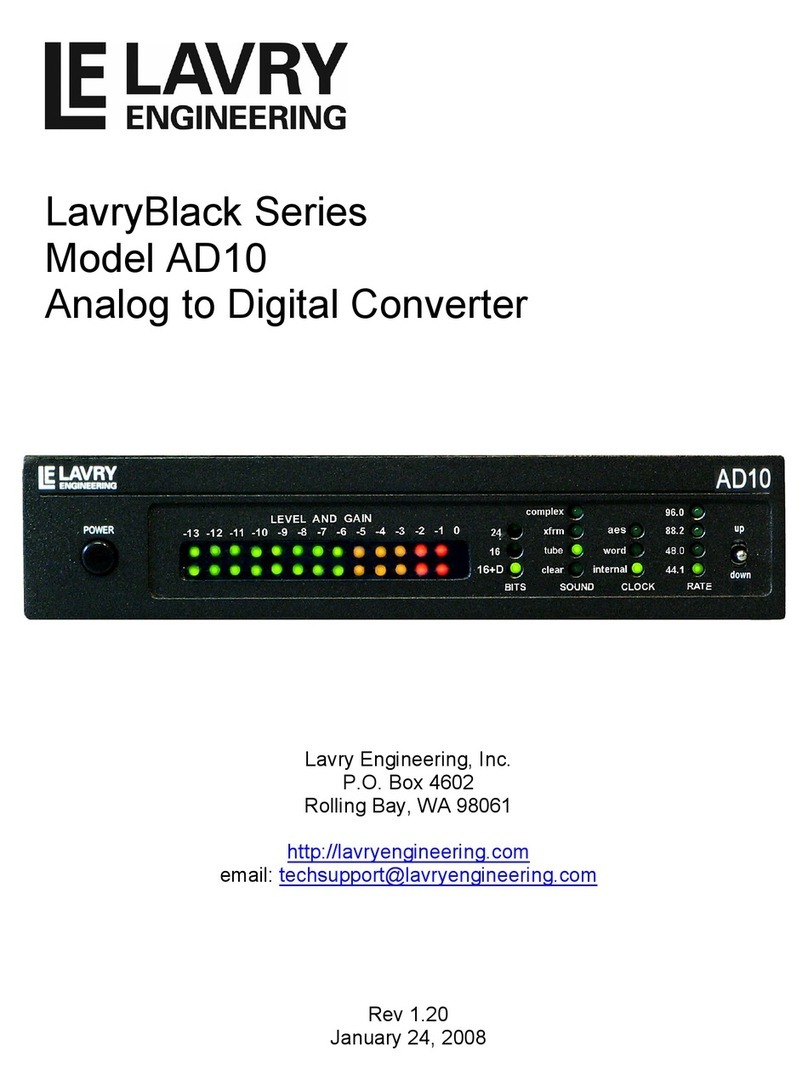
Lavry
Lavry LavryBlack Series User manual

Lavry
Lavry AD11 User manual

Lavry
Lavry DA10 User manual
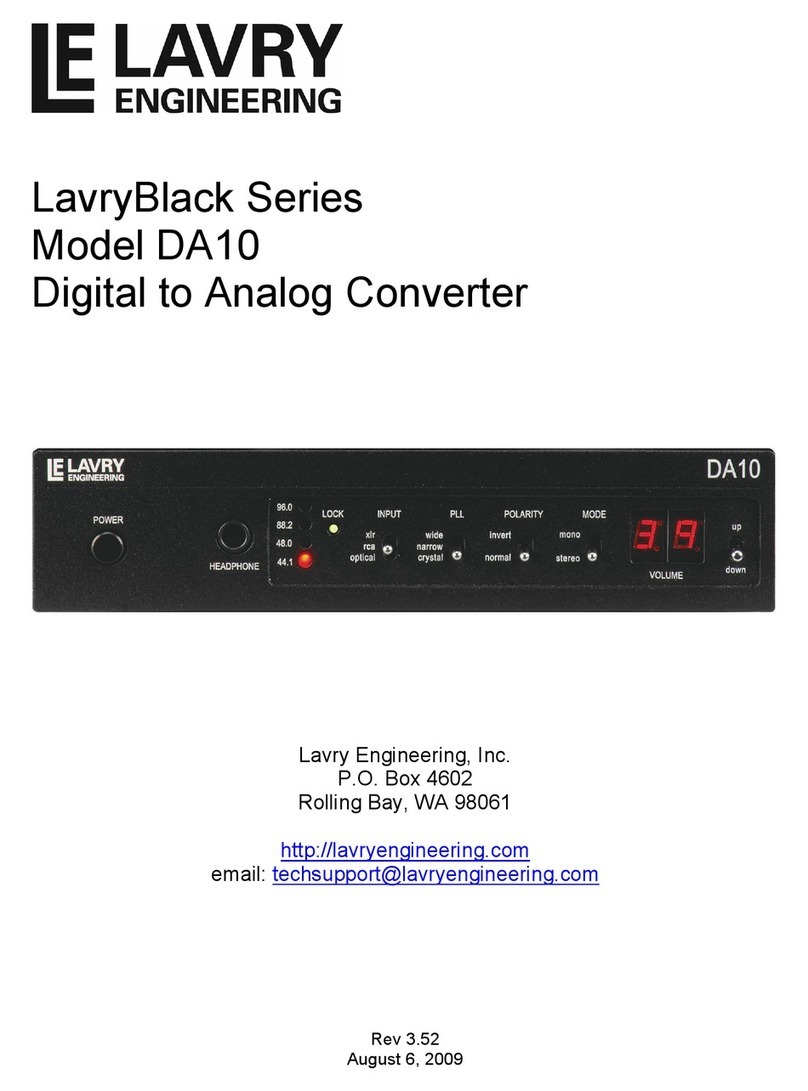
Lavry
Lavry DA10 User manual

Lavry
Lavry LavryBlack Series User manual

Lavry
Lavry DA924 User manual

Lavry
Lavry DA11 User manual
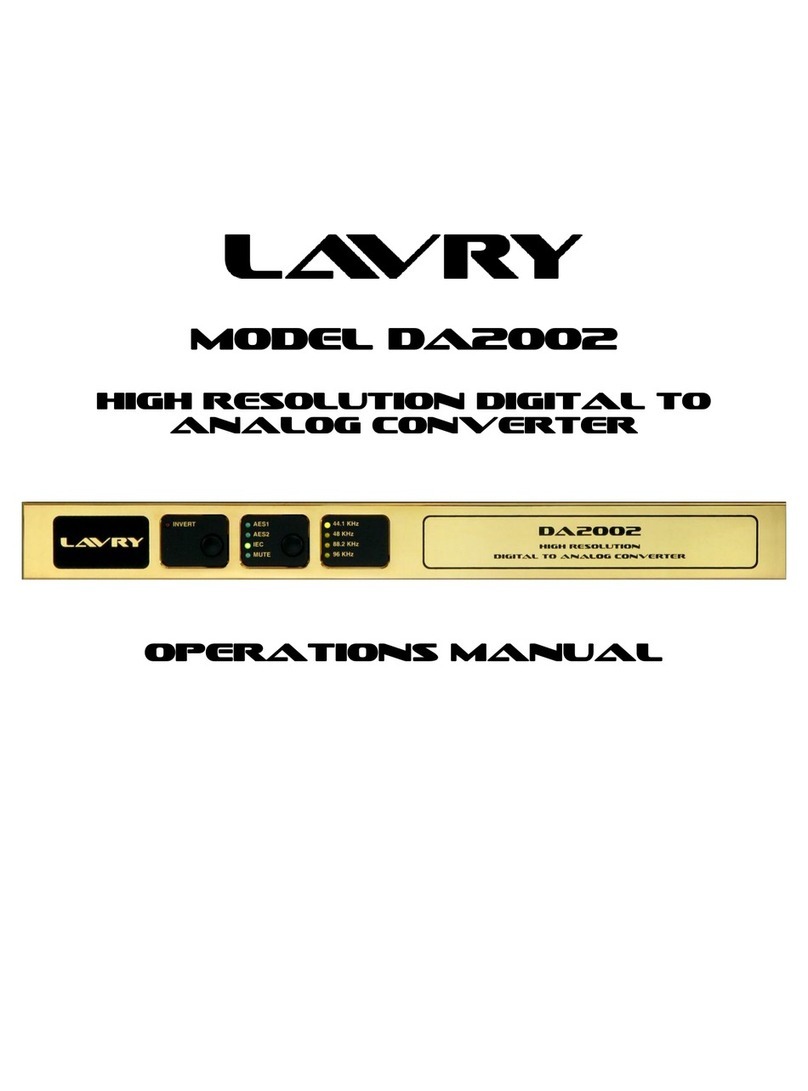
Lavry
Lavry DA2002 User manual

Lavry
Lavry M AD-824 User manual
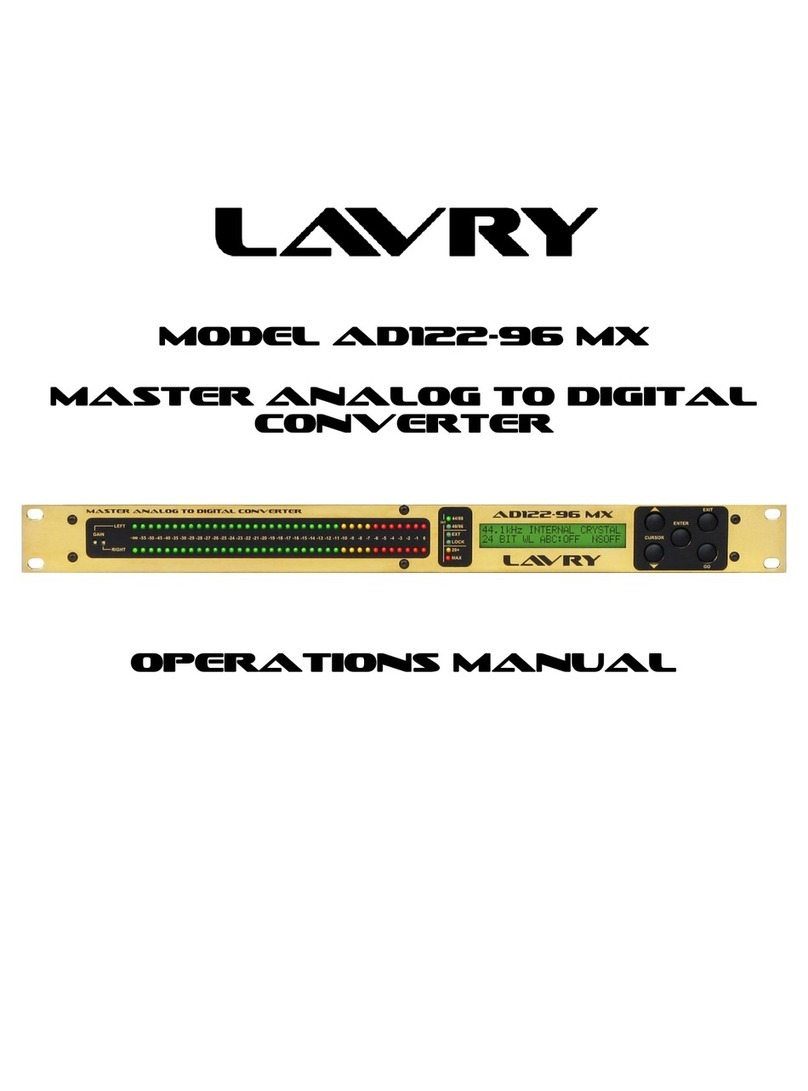
Lavry
Lavry AD122-96 MX User manual


